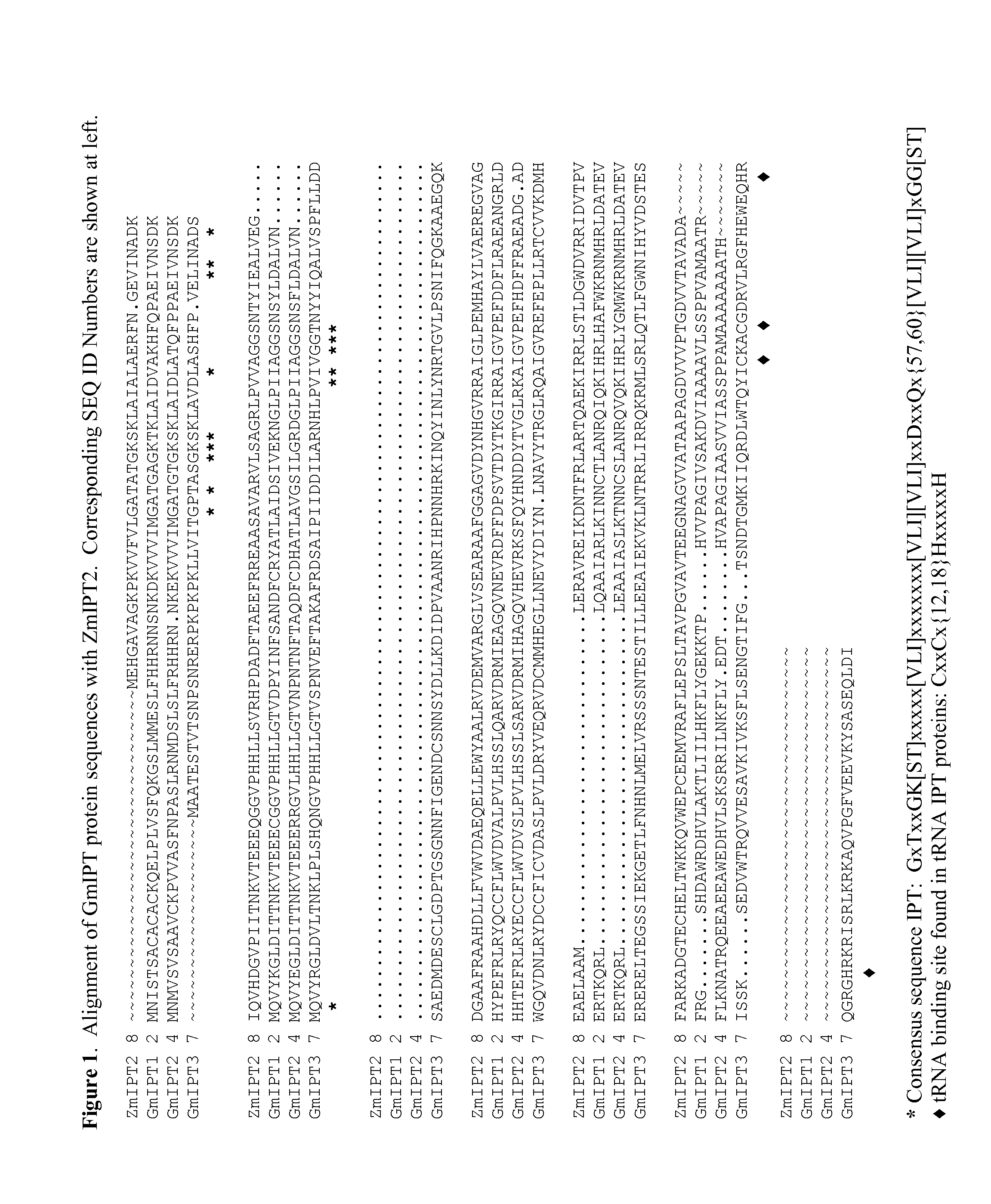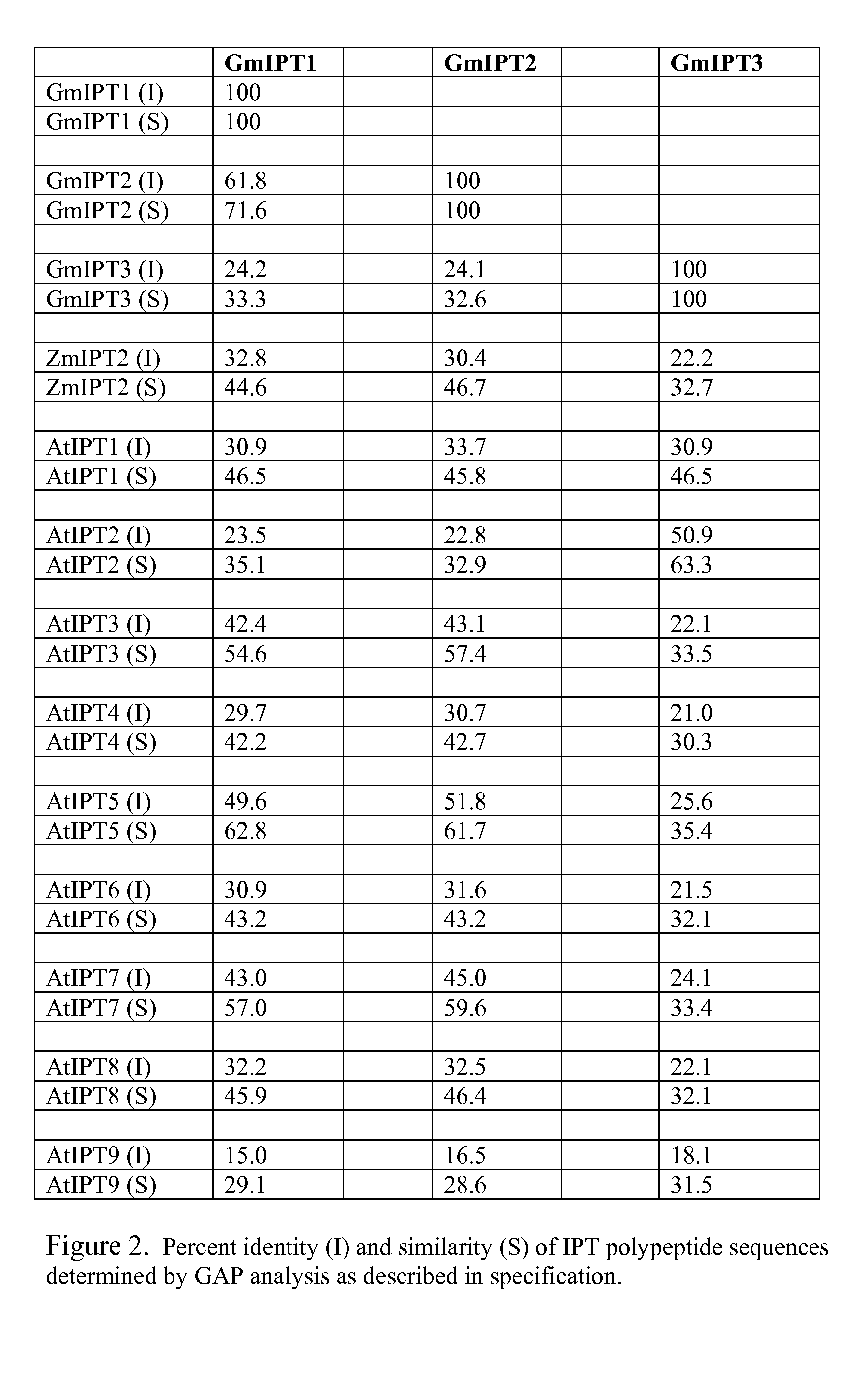Soybean isopentenyl transferase genes and methods of use
a technology of soybean isopentenyl transferase and gene, applied in the field of gene activity modulation of plants, to achieve the effects of modulating (increased or decreased) cytokinin levels, modulating root development, and modulating floral developmen
- Summary
- Abstract
- Description
- Claims
- Application Information
AI Technical Summary
Benefits of technology
Problems solved by technology
Method used
Image
Examples
example 1
Cloning and Gene Characterization of GmIPT1 and GmIPT2
[0263]Below we describe the identification and characterization of two IPT polypeptides from soybean (Glycine max) designated GmIPT1 and GmIPT2.
[0264]Material and methods: Sequences putatively representing IPT genes in soybean were initially identified by an in silico search of soy EST databases using known Arabidopsis and maize IPT coding sequences. Two candidate ESTs, pk0031 and pk086, were selected based on protein-level homology to the reference sequences and consideration of the library from which the candidate sequence originated.
[0265]Based on the candidate EST sequences, primers 100066, 100067, 100068, and 100069 (SEQ ID NOs: 10-13, respectively) were created. Primer pairs 100066 / 100067 and 100068 / 100069 were used to screen a proprietary soybean BAC library. Super-pools identified were further screened with primer pair 100066 / 100067 and two BAC clones, CO5 and 124, were selected.
[0266]In each case, touchdown PCR was perfo...
example 2
Expression of GmIPT Genes
[0271]In order to study the level of expression of the GmIPT genes in various plant tissues, MPSS™ analysis (Solexa, Inc., Hayward, Calif.) was performed using 17-mer tags as shown in SEQ ID NOS: 14-16. In general, expression was found to be very low in most organs, but higher in reproductive tissues such as flowers (GmIPT1 and 2) and seed (GmIPT3). Tissue types, number of library hits, and average ppm for each are presented in Table 1.
[0272]
TABLE 1TissueGenetypeAverage ppm# of librariesGmIPT1Flower32.11GmIPT1Leaf3.52GmIPT1Stem14.01GmIPT1Root8.01GmIPT2Flower68.56GmIPT2Leaf25.02GmIPT2Root15.52GmIPT2Seed13.25GmIPT3Leaf3.01GmIPT3Root5.54GmIPT3Seed13.312
[0273]Northern blots of GmIPT1 and GmIPT2 confirmed these findings. The expression pattern of GmIPT1 and GmIPT2 was further studied using Northern blot with RNA samples extracted from different soybean tissues (flowers, pods at different developmental stages, leaf, stem and root). GmIPT1 (AY550884) is expressed i...
example 4
Maintaining or Increasing Seed Set During Stress
[0278]Targeted overexpression of the IPT sequences of the invention to the developing female inflorescence of angiosperms, for example maize, soy, rice, or wheat, will elevate cytokinin levels and allow developing seed to achieve their full genetic potential for size, minimize seed and / or pod abortion, and buffer seed set during unfavorable environments. Abiotic stress that occurs during seed development in maize has been shown to cause reduction in cytokinin levels. Under stress conditions, it is likely that cytokinin biosynthesis activity is decreased and cytokinin degradation is increased (Brugiére, et al., (2003) Plant Physiol. 132(3):1228-40). Consequently, in one non-limiting method, to maintain cytokinin levels in lag-phase seeds, IPT genes could be ligated to control elements that: 1) are stress insensitive; 2) direct expression of structural genes predominantly to the developing seeds; and 3) preferentially drive expression of...
PUM
| Property | Measurement | Unit |
|---|---|---|
| temperature | aaaaa | aaaaa |
| temperature | aaaaa | aaaaa |
| pH | aaaaa | aaaaa |
Abstract
Description
Claims
Application Information
 Login to View More
Login to View More - R&D
- Intellectual Property
- Life Sciences
- Materials
- Tech Scout
- Unparalleled Data Quality
- Higher Quality Content
- 60% Fewer Hallucinations
Browse by: Latest US Patents, China's latest patents, Technical Efficacy Thesaurus, Application Domain, Technology Topic, Popular Technical Reports.
© 2025 PatSnap. All rights reserved.Legal|Privacy policy|Modern Slavery Act Transparency Statement|Sitemap|About US| Contact US: help@patsnap.com



